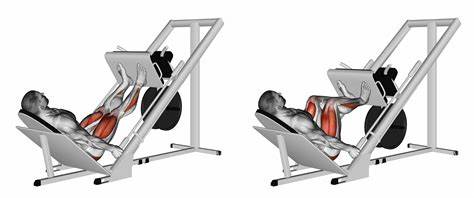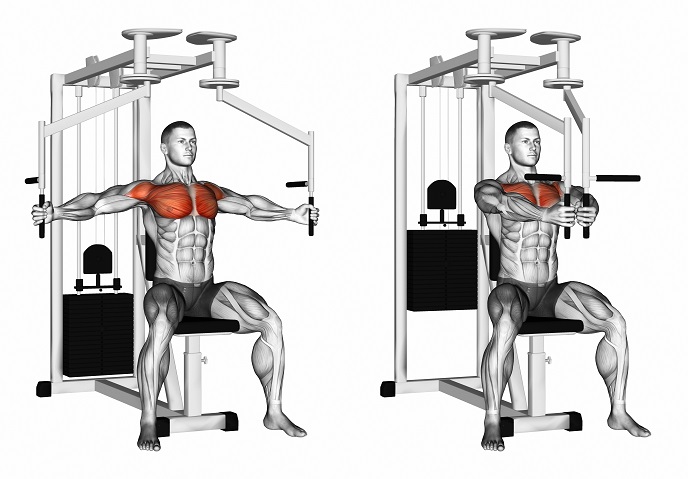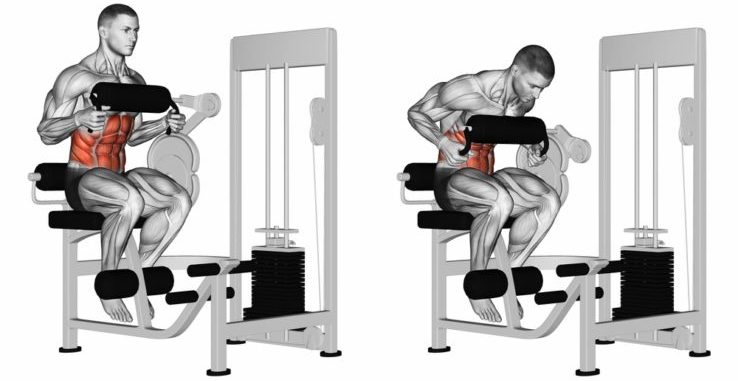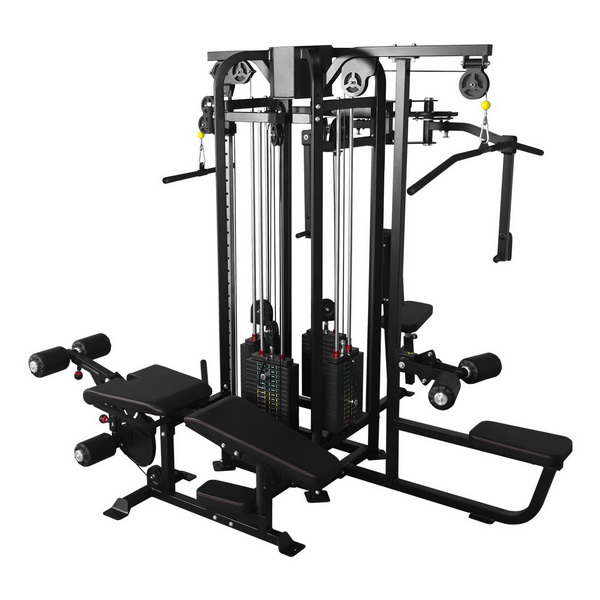Your strength and hypertrophy training will be more successful if you use well-designed gym equipment. By reducing instability, they let you target and overwork particular muscles. In contrast to free weights, they may impart varied resistance and resistance to specific movement patterns. When working with big loads or training to failure, sound machines can also increase safety.
The issue is that not every piece of equipment at the gym is effective, worthwhile, or good. To start, let me say that this review is not the viewpoint of some two-bit trainer or frail physiotherapist who labels random equipment as “injurious” or “non-functional.”
A strength coach and physical therapist who utilizes some machines on the same frequency as free weights provide an unbiased, biomechanics-based, physiologically informed debate. Having said that, not every machine is made equally. Here are five machines and five machine-related problems to stay away from.
The 5 Worst Machines Exercices
- Squat Machines
- High Five Pec-Deck
- Crummy Crunch Machines
- Standing Calf Raise Machines
- Combo Machines
The 5 Worst Machine Problems
- Full of Friction
- Insufficient Support
- Not Fitting Your Body
- Poor Resistance Curve
- Redundant to Effective Free Weight Options
The 5 Worst Machines Exercices
Because they “take” more strain and work than they “give,” certain equipment should be avoided. You should double-check your training program to determine whether any of this unnecessary equipment is included if you’re concerned about training successfully and efficiently.
Squat Machines
Many athletes could find it difficult to squat with free weights to their maximum depth. Lack of coordination, restricted ankle flexibility, or uncertainty about one’s ability to rise up after striking depth are a few potential causes of this.
Leg presses, hack squats, and other lower-body equipment that improves a lifter’s capacity to complete the “squat” movement pattern with a full range of motion are priceless (or, more specifically, iron).

The amount of ankle dorsiflexion (lifting your toes towards your shin) necessary to hit depth is reduced for lifters with tight ankles by positioning your feet higher or further front on the platform. Lifters with poor trunk control benefit from the machine’s upper-body assistance and coaching.
Why Avoid Them
You hop on a brand-new hack squat or leg press, which you may have done before. Up until the halfway point of the exercise, everything feels fine. Clunk Before achieving the anticipated “ass-to-grass” position of complete hip and knee flexion, you’ve struck the machine’s safety stop.
Even if the machine had generally operated without a hitch, its design may be shorting you more than your depth. You are probably being robbed of prospective benefits.
High Five Pec-Deck
A long time ago, the “high five” arm posture appears to be a prevalent poorly thought-out design feature among many pec-deck or chest flye machines. Users of the device must sit with their arms at shoulder height somewhat behind their bodies, externally rotate their shoulders, and then position their forearms in touch with vertical pads.

The user pulls the pads in front of their chest toward one another to complete the workout. The pectoralis major, anterior deltoid, subscapularis, and a few supporting muscles are all trained with these devices. They are still accessible in public and private gyms.
Why Avoid Them
There is nothing intrinsically “wrong” with this equipment, to be clear. Unquestionably, it strikes the pecs. The fact that the pectoralis major is put under a lot of passive strain during complete shoulder external rotation means that the muscle’s overall contribution is probably underestimated.
The “high five” pec-drawback decks are not that exercise is ineffective; rather, it is that lifters who already have shoulder problems are unlikely to handle it well. For instance, every single weightlifter tested by a team of doctors who had sore shoulders reported reproducing their shoulder discomfort in the “high five” position.
Crummy Crunch Machines
The only real benefit of most abdominal machines is that they will get you off the gym floor. The majority of plate-loaded and stack-loaded crunch machines are made to be utilized sitting or lying down.

Their fundamental issue isn’t that their designs frequently limit a multi-joint spinal movement pattern to a single pivot point. Their range of motion is inadequate for developing stronger, more attractive abs.
Why Avoid Them
Whether you utilize a sitting or supine (lying down) crunch machine, you only exercise through a part of your possible trunk flexion range of motion. Many of your spinal joints are already flexed by the time you encounter the machine’s resistance, and the abdominals are only worked at their shorter length.
Growing data points to the benefits of exercising at long muscle lengths rather than short ones for muscular growth. Therefore, training over the whole range of spinal flexion is a superior alternative if you’re a healthy lifter looking to develop a more noticeable six-pack.
With your back stretched and arched, begin your crunch. You may do this by performing sit-ups with control and a complete range of motion while locked into a glute-ham developer (GHD) machine, or you can execute crunches on top of a Swiss ball.
Standing Calf Raise Machines
Calf raises may be performed without having to hold any heavy weights thanks to standing calf raise equipment. Additionally, they offer a secure setting that allows the lifter to concentrate on developing large, powerful gastrocnemius muscles, which are worked throughout any straight-knee calf raise exercise.
Usually, the calves are loaded into these devices through pads that sit atop the upper traps. As a result, the standing calf raise is an axially-loaded exercise, meaning that, like squats and deadlifts, the weight is supported via the trunk and spine.
Combo Machines
Multi-function equipment may lure gym operators with limited floor space or a tight budget. Functional trainers and cable columns are the “jack-of-all-trades, master-of-none” machines at the gym. These devices are standard fare, and they often function without issue. However, some multifunction devices are really subpar.

No matter the brand or manufacturer, the plate-loaded leg extension/leg curl combination is multi-purpose equipment that is always bad. These devices combine a prone hamstring curl with a sitting leg extension. Theoretically, these devices are an excellent, space-efficient station for working out two significant muscle groups. In truth, you’ll understand why they are on this list after your first set.
The 5 Worst Machine Problems
Some computers don’t have a bad nature; they only have issues that may be resolved with enough upkeep, the right configuration, or a change in the general program design. Here are several warning signs.
Full of Friction
Have you ever experienced a grinding or jerking sensation during a mechanical lift? Or perhaps you’ve noticed that a weight stack won’t start to move until you push or pull through a lot of “slop” or play in a machine’s cables and pulleys? If so, there is a friction problem.
Guide rods that are bent, rusty, or insufficiently lubricated, cable sheathing that is worn or cracked, or worn bearings are common sources of friction in exercise equipment. Some machines have a lot of friction when they are brand-new, especially ones with several pulleys and lengthy belts or cables. Using high-friction equipment might cost you more than just a comfortable lifting experience.
Insufficient Support
You should be able to lock in proper form and efficiently load the training movement pattern with the aid of well-designed devices. Excellent machinery is highly efficient. For instance, studies revealed that training on an isolated lumbar extension machine for 10 weeks was better than training with the Romanian deadlift for enhancing lumbar extension strength.
However, many other lumbar extension machines do not include a seat belt to support hips throughout the workout, in contrast to the widely coveted MedX model. It is fair to assume that these devices are only sporadically effective.
Speaking of seat belts, if you’ve ever used a seated dip machine without a belt or padding to keep you firmly in place, you’ve probably seen this strange phenomenon: try to press down with greater pressure than a specific proportion of your body weight, and you’ll get up out of the chair. A design defect that nevertheless managed to reach the market is represented by a lack of support.
Cable hip extension machines and rotary hip extension machines are given honorable mentions in this category (e.g. 4-way hip). When using these devices, you stand on one leg and stretch the other leg against resistance provided by a cable or pad.
Not Fitting Your Body
Even for a lifter who is clearly average in size, running into equipment that doesn’t fit your physique is typical. You should anticipate encountering this problem more frequently if your anthropometry, or body proportion, deviates from the demographic mean.
Avoid using equipment whose axis of motion isn’t in line with your main functioning joint. Single-joint machines for triceps extensions, prone hamstring curls, leg extensions, and arm curls appear to be the main offenders.
Also, watch out for equipment that is too tall or too short for your height. For instance, if a machine is designed to be operated with feet on the floor, you shouldn’t use it with your feet hanging down. Or perhaps you have long legs and can’t push or row using the complete range of motion on a certain gym machine.
Poor Resistance Curve
The resistance curve of a machine depicts the pattern of varying resistance the user encounters throughout the exercise’s range of motion. Levers and oddly shaped cams can be used in machines to offer varying resistance to the lifter.
The Nautilus cam with its shell-like form is a prime illustration of changing resistance. During the portion of the exercise when the lifter is stronger, the cam was designed to provide more resistance, and less resistance, where the lifter is weaker.
The resistance curve should mirror the overall strength curve of the movement pattern, even if no machine can match each lifter’s strength curve or ability to display strength across the range of motion.
Theoretically, machines designed to fit the typical human strength curves should be preferable to free weights, which rely on gravity to produce a constant resistance. It should be mentioned that there is no agreement on whether free weight training or variable resistance training is better for boosting strength.
Redundant to Effective Free Weight Options
Some free weight workouts are absolutely outstanding and ought to be included in your routine. A shrug machine cannot beat the trap bar. Use heavy weights while sitting on a bench to do seated shrugs.
It’s OK to enter the squat rack for rack pulls. A good old barbell lifted from the safety catches works just fine and, according to the specificity principle, has perhaps better carryover to your standard deadlift than the Smith machine, which was once the go-to for this exercise.
The key is that nothing needs to be invented from scratch. And that message has to go to both gym operators and makers of gym equipment.
